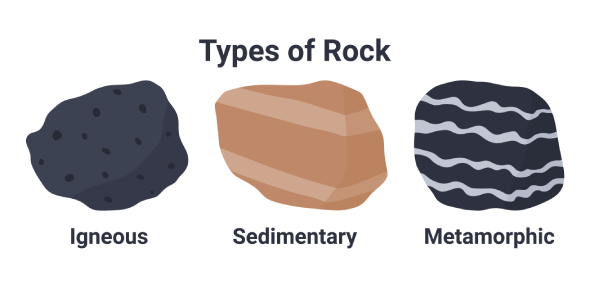Rocks and Minerals: Types, Formation, and Key Properties
Lesson Overview
- Basic Types of Rocks: Igneous, Sedimentary, and Metamorphic
- Formation of Igneous Rocks: Cooling of Molten Magma
- Formation of Metamorphic Rocks: Heat and Pressure
- Transport of Sediments: Movement by Rivers
- Fossils in Sedimentary Rocks: Preservation in Layers
- Physical Properties of Rocks and Minerals: Key Identification Traits
- Sequence of Sedimentary Rock Formation: Step-by-Step Process
- Agents of Weathering: Forces Breaking Rocks
- Types of Igneous Rocks: Intrusive and Extrusive
- Rock Cycle Events: Continuous Changes in Rocks
Rocks and minerals make up the solid crust of Earth. This lesson explains the types of rocks, how they form, and key properties to identify them, preparing you for the quiz on rocks and minerals.

Basic Types of Rocks: Igneous, Sedimentary, and Metamorphic
Rocks on Earth are mainly igneous, sedimentary, or metamorphic. Igneous rocks form from cooled magma or lava. Sedimentary rocks develop from layers of sediments pressed together over time. Metamorphic rocks change when heat and pressure reshape existing rocks.
Example: Granite is igneous, formed from cooled magma. Sandstone is sedimentary, made from compacted sand layers. Marble is metamorphic, created when limestone undergoes heat and pressure.
Quick Tip: Connect igneous to "fire," sedimentary to "sediment," and metamorphic to "changed form."
Formation of Igneous Rocks: Cooling of Molten Magma
Igneous rocks form when molten magma or lava cools and hardens. Cooling can happen slowly underground or quickly on the surface. Slow cooling creates large crystals, while fast cooling forms small crystals.
Example: Granite forms underground with large crystals due to slow cooling. Basalt forms on the surface with small crystals after rapid lava cooling.
Quick Tip: Slow cooling creates bigger crystals, like freezing water slowly.
Take This Quiz:
Formation of Metamorphic Rocks: Heat and Pressure
Metamorphic rocks form when existing rocks undergo heat and pressure deep inside Earth. These forces change mineral structure without melting the rock completely.
Example: Slate forms from shale when exposed to heat and pressure underground.
Quick Tip: Metamorphic means "changed form" by heat and pressure, not melting.
Transport of Sediments: Movement by Rivers
Sediments are small rock particles moved by natural forces like rivers. Rivers carry sediments downstream until water slows, causing sediments to settle and form layers.
Example: The Mississippi River carries sand and silt to the Gulf, where sediments settle.
Quick Tip: Think of sediments as passengers riding rivers until they reach a stop.
Fossils in Sedimentary Rocks: Preservation in Layers
Fossils form when plants or animals are buried in sediment. Sedimentary rocks preserve fossils because sediments build up gently without heat or pressure that would destroy remains.
Example: Dinosaur bones are found in sedimentary rocks like sandstone.
Quick Tip: Fossils are rarely in igneous or metamorphic rocks due to heat.
Take This Quiz:
Physical Properties of Rocks and Minerals: Key Identification Traits
Physical properties like color, hardness, luster, cleavage, and density help identify rocks and minerals. These traits are observable without changing the rock's makeup.
Example: Quartz is hard, often clear or white, with a glassy shine, helping identify it.
Quick Tip: Test hardness by scratching; harder minerals scratch softer ones.
Sequence of Sedimentary Rock Formation: Step-by-Step Process
Sedimentary rocks form through weathering breaking rocks, erosion moving particles, deposition settling them, compaction squeezing layers, and cementation binding sediments into rock.
Example: Sand breaks off cliffs (weathering), moves in rivers (erosion), settles on beaches (deposition), layers press together (compaction), and minerals glue grains (cementation).
Quick Tip: Think of sedimentary rocks as layered like a cake, built step-by-step.
Agents of Weathering: Forces Breaking Rocks
Agents of weathering include rain, frost, wind, and living things. They break down rocks physically or chemically. Clouds do not cause weathering.
Example: Frost cracks rocks by freezing water in cracks; wind wears down rock surfaces.
Quick Tip: Weathering changes rocks but doesn't move pieces; that is erosion.
Types of Igneous Rocks: Intrusive and Extrusive
Intrusive igneous rocks form when magma cools slowly underground, making large crystals. Extrusive igneous rocks form when lava cools quickly on the surface, making small crystals.
Example: Granite is intrusive with large crystals; basalt is extrusive with small crystals.
Quick Tip: Intrusive means inside Earth; extrusive means outside on the surface.
Take This Quiz:
Rock Cycle Events: Continuous Changes in Rocks
The rock cycle shows how rocks change form. Magma cools to igneous rocks. Heat and pressure form metamorphic rocks. Sediments form sedimentary rocks through erosion and deposition. Sediments do not form deep underground.
Example: Granite forms from cooling magma; limestone changes to marble under heat and pressure.
Quick Tip: Rocks can change types over millions of years through the rock cycle.
Rate this lesson:
 Back to top
Back to top


